This Week’s Sky at a Glance, July 29 – August 6
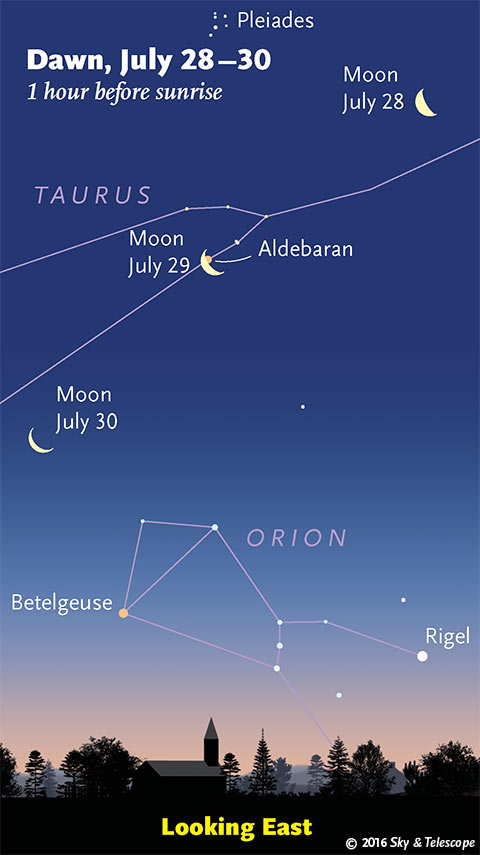
On Saturday morning the 30th in early dawn, the waning crescent Moon forms a long, tall triangle with orange Aldebaran to its upper right and orange Betelgeuse to its lower right.
Friday, July 29
• Bright Vega now passes almost straight overhead around 11 p.m. daylight-saving time, depending on your location. As with all star configurations, you'll see this happening two hours earlier each month.
Saturday, July 30
• As summer proceeds, Scorpius shifts westward from its highest stance in the south just after dark, and Sagittarius moves in from the east to take its place. So we're entering prime time for the profusion of Messier objects in and above Sagittarius. How many can you locate with a map and binoculars?
Start with M8, the big Lagoon Nebula. It's 6° above the spout-tip of the Sagittarius Teapot pattern.
Sunday, July 31
• The tail of Scorpius lies low in the south-southwest right after dark. Look for the two stars especially close together in the tail. These are Lambda and fainter Upsilon Scorpii, known as the Cat's Eyes. They're canted at an angle; the cat is tilting his head and squinting one eye.
The Cat's Eyes point west (right) by nearly a fist-width toward Mu Scorpii, a much tighter pair known as the Little Cat's Eyes. It takes very sharp vision to resolve Mu without binoculars!
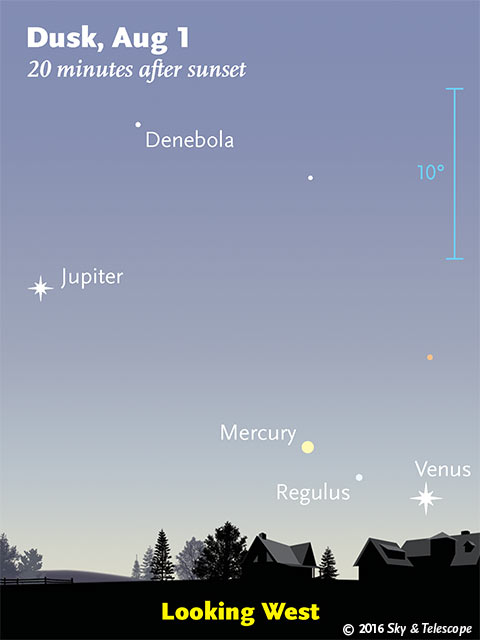
Use binoculars to see through the bright twilight to collect the full lineup of Jupiter, Mercury, Regulus, and Venus. The blue 10° scale is about the width of your fist at arm's length.
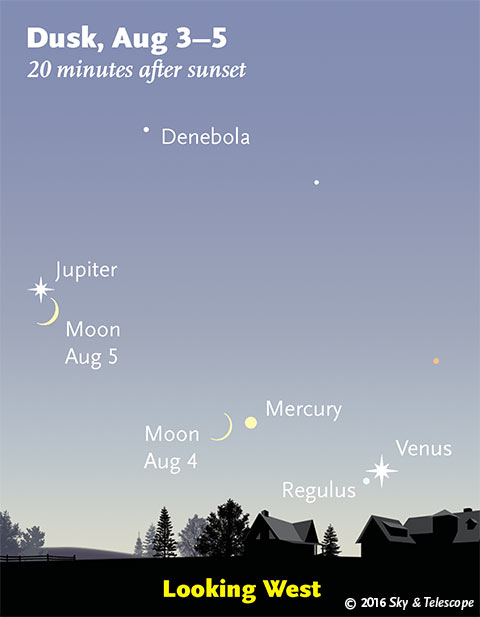
The lineup shifts as Regulus passes under Venus — while the waxing crescent Moon emerges in the evening twilight near Mercury and then Jupiter.
Monday, August 1
• Shortly after sunset, Jupiter, Mercury, faint Regulus, and Venus form a diagonal line in the west, as shown here. The line is 27° long. Look early in twilight and bring binoculars, because Venus is only about 4° high even just 20 minutes after sundown (for skywatchers near 40° north latitude). Regulus may be impossible. Good luck.
Tuesday, August 2
• Explore faint little Lacerta, the Lizard tucked between Deneb and Cassiopeia, using binoculars and Mathew Wedel's Binocular Highlights column and map in the August Sky & Telescope, page 43. Can you make out the little arrowhead of NGC 7243?
• New Moon (exact at 4:45 p.m. Eastern Daylight Time).
Wednesday, August 3
• As twilight fades away, Vega shines near the zenith (if you're in the mid-northern latitudes), and Arcturus shines in the west.
A third of the way from Arcturus up to Vega, look for Corona Borealis, the Northern Crown, with its one modestly bright star: Alphecca or Gemma.
Two thirds of the way from Arcturus to Vega is the dim Keystone of Hercules, with its 6th-magnitude globular cluster M13.
Thursday, August 4
• Venus-Regulus conjunction. Shortly after sunset this evening and tomorrow evening, Regulus is hardly more than 1° from much brighter Venus. About 15 or 20 minutes after your local sunset time, scan for Venus very low above the western horizon with binoculars or a wide-field telescope. Tonight Regulus is to Venus's lower left (for North America), as shown above. On Friday Regulus is below Venus.
Friday, August 5
• The crescent Moon poses with Jupiter low in the west in twilight, as shown here.
• The Big Dipper hangs diagonally in the northwest after dark. From its midpoint, look to the right to find Polaris (not very bright) glimmering due north as always.
Polaris is the handle-end of the Little Dipper. The only other parts of the Little Dipper that are even modestly bright are the two stars forming the outer end of its bowl. On August evenings they're about a fist and a half (at arm's length) to Polaris's upper left. They're called the Guardians of the Pole, since they circle around Polaris throughout the night and throughout the year.
Saturday, August 6
• Today is the midpoint of astronomical summer: halfway between the June solstice and the September equinox (even though August 1st, Lammas Day, is generally celebrated as the "cross-quarter" day). The exact midpoint of summer is at 2:28 p.m. Eastern Daylight Time (18:28 UT).
• Accordingly, the "Spring Star" Arcturus now shines only moderately high in the west after dark, heading down — while the Great Square of Pegasus, emblem of autumn, is low in the east coming up. Look for the Great Square balanced on one corner. It's about 15° on a side, larger than your fist at arm's length.
_________________________
Want to become a better astronomer? Learn your way around the constellations! They're the key to locating everything fainter and deeper to hunt with binoculars or a telescope.
This is an outdoor nature hobby. For an easy-to-use constellation guide covering the whole evening sky, use the big monthly map in the center of each issue of Sky & Telescope, the essential guide to astronomy.
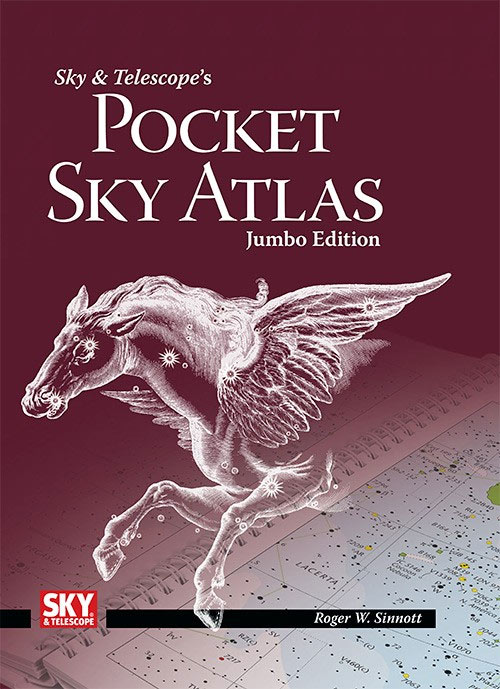
The Pocket Sky Atlas plots 30,796 stars to magnitude 7.6 — which may sound like a lot, but it's less than one per square degree on the sky. Also plotted are many hundreds of telescopic galaxies, star clusters, and nebulae. Shown above is the new Jumbo Edition for easier reading in the night. Click image for larger view.
Once you get a telescope, to put it to good use you'll need a detailed, large-scale sky atlas (set of charts). The basic standard is the Pocket Sky Atlas(in either the original or new Jumbo Edition), which shows stars to magnitude 7.6.
Next up is the larger and deeper Sky Atlas 2000.0, plotting stars to magnitude 8.5, nearly three times as many. The next up, once you know your way around, is the even larger Uranometria 2000.0(stars to magnitude 9.75). And read how to use sky charts with a telescope.
You'll also want a good deep-sky guidebook, such as Sue French's Deep-Sky Wonders collection (which includes its own charts), Sky Atlas 2000.0 Companion by Strong and Sinnott, or the biggerNight Sky Observer's Guide by Kepple and Sanner.
Can a computerized telescope replace charts?Not for beginners, I don't think, and not on mounts and tripods that are less than top-quality mechanically (meaning heavy and expensive). And as Terence Dickinson and Alan Dyer say in theirBackyard Astronomer's Guide, "A full appreciation of the universe cannot come without developing the skills to find things in the sky and understanding how the sky works. This knowledge comes only by spending time under the stars with star maps in hand."
This Week's Planet Roundup
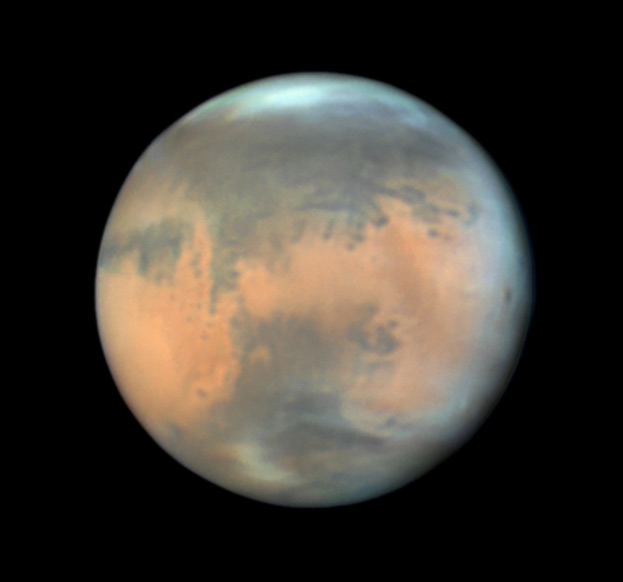
Mars as imaged by Damian Peach on June 8th, when it was still a big 18.4 arcseconds in diameter. The dark Sinus Sabaeus - Sinus Meridiani feature intrudes around the left (celestial west; preceding) limb. The bright Chryse region is dead center. The South Polar Cloud Hood is prominent at top, and morning clouds limn the celestial-eastern (following) limb.
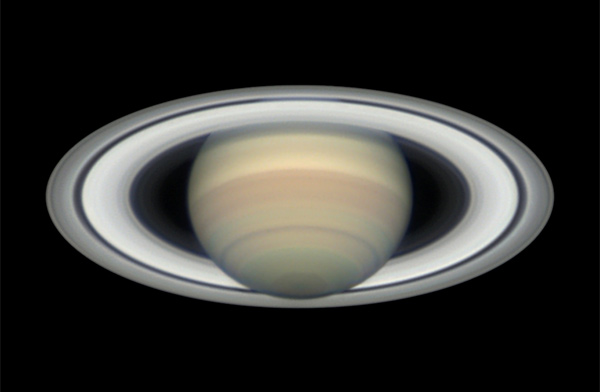
Two days after Saturn's June 3rd opposition, Damian Peach took this image unambiguously showing the Encke Gap just inside the edge of the outer A ring, and the dusky C ring both against the globe and against the dark-sky background. The rings, practically at their widest open, extend above and below Saturn's south and north poles this season. South is up. The shape of the North Polar Hexagon is clearly evident.
Mercury and Venus are very low in bright twilight. About 15 minutes after sunset, use binoculars or a wide-field telescope to start scanning for Venus just above the west-northwest horizon. Venus is magnitude –3.9; Mercury is about magnitude –0.1 (1/35 as bright) and fading. Look for Mercury about 8° to Venus's upper left this week.
Mars (magnitude –0.7, just to the right of the head of Scorpius) is moving eastward (leftward) against the stars, back toward Saturn and Antares. The three form an ever-shrinking triangle in the south-southwest at nightfall. The triangle will turn into an almost straight, vertical line on August 23rd and 24th, when Mars slingshots between the other two.
In a telescope this week, Mars is still 13 arcseconds in diameter and very plainly gibbous.
Jupiter (magnitude –1.7, between Leo and Virgo) is low due west in twilight. It sets around twilight's end.
Saturn (magnitude +0.3, in southern Ophiuchus) shines in the south at dusk, 6° above fainter Antares and about 11° upper left of bright Mars.
The brightest star in the upper edge of this triangle is the long-term eruptive variable Delta Scorpii (Dschubba). It's also the middle star of the vertical row marking the Scorpion's head.
Uranus (magnitude 5.8, in Pisces) and Neptune(magnitude 7.8, in Aquarius) are very high in the southern sky well before the first light of dawn. Info and finder charts.
__________________________
All descriptions that relate to your horizon — including the words up, down, right, and left — are written for the world's mid-northern latitudes. Descriptions that also depend on longitude (mainly Moon positions) are for North America.
Eastern Daylight Time (EDT) is Universal Time (UT, UTC, or GMT) minus 4 hours.
__________________________
“This adventure is made possible by generations of searchers strictly adhering to a simple set of rules. Test ideas by experiments and observations. Build on those ideas that pass the test. Reject the ones that fail. Follow the evidence wherever it leads, and question everything. Accept these terms, and the cosmos is yours.”
— Neil deGrasse Tyson
No comments:
Post a Comment